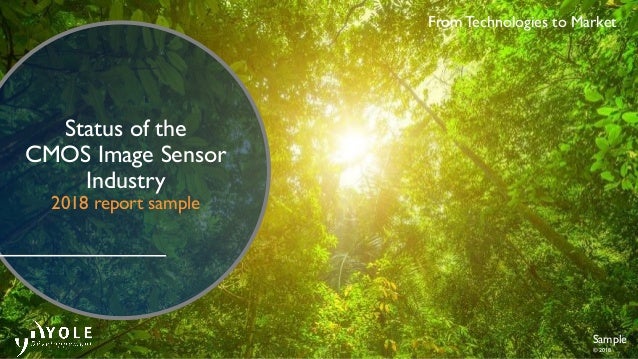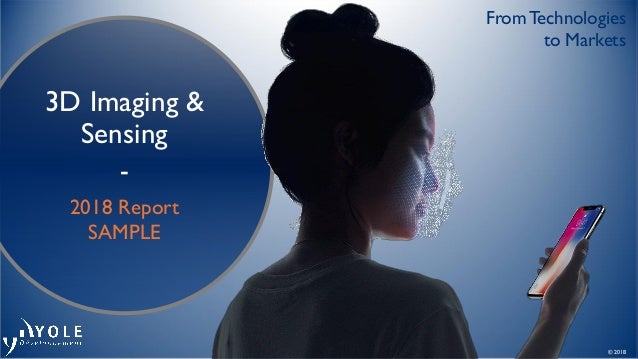CMOS image sensors (CIS) have become key components of the semiconductor industry. This is not only because of the technology involved and the revenue it generates, but also because it is now impossible to imagine a smartphone, a car or even a house without numerous enabling cameras. The CIS industry reached $13.9B in 2017 and Yole Developpement (Yole) is expecting a CAGR of 9.4% for the next 5 years, as shown in the newly released report “Status of the CMOS Image Sensor Industry 2018”.
Among the major companies leading this industry is Omnivision which was acquired by a Chinese investment group in 2016. Pierre Cambou, Imaging Technology & Market Principal Analyst for Yole has had the chance to interview Michael Wu, Senior VP Global Marketing and Sales, OmniVision to discuss the future of the company and of the industry as a whole.
Pierre Cambou (PC): Can you provide an overview of OmniVision and its position within the CMOS Image Sensor (CIS) ecosystem?
Michael Wu (MW): OmniVision is one of the pioneers in the CMOS image sensor (CIS) industry. Headquartered in Santa Clara, Calif., the company was founded in 1995 and has since been providing state-of-the-art imaging system solutions for the mobile, automotive, security, emerging and medical markets. Our complete portfolio includes a wide range of image sensors, algorithms, ASICs/SoCs, LCOS panels and CameraCubeChips (wafer-level optics).
With design and R&D centers worldwide, including the U.S., Norway, Japan, China and Singapore, OmniVision has 17 office locations, roughly 1,600 employees and more than 3,800 patents globally. Over the past 23 years, our total shipment number has reached over 9 billion units. In terms of shipment volume, we are leading in all CIS application segments with great customer acceptance and a proven global track record. In terms of unit shipments, we are No. 3 in mobile, No. 2 in automotive and security, and No. 1 in notebooks, medical and emerging markets.
Supporting a sustainable ecosystem in the imaging industry is extremely important. We work very closely with key partners in all market segments to deliver complete imaging solutions to our customers. For example, in mobile, we work closely with the top three AP/modem design houses that have the capability of self-developing and qualifying driver and image-quality tuning for mobile platforms. These partnerships are extremely valuable to our customers (tier-1s as well as tier-2/3s) in reducing their time-to-market and development resources. Additionally, in some vertical segments (for example, medical and wireless low-power home surveillance), we provide not just CIS, but also complete ISP/SoC solutions to help reduce time-to-market and better enable long-term strategic partnerships.
PC: Since the change in shareholders two years ago, can you explain to our readers what has changed for the company?
MW:
Our IPO on the Nasdaq Exchange was in 2000. In 2016, we went private. Since September 2017, Mr. Renrong Yu has been OmniVision CEO and he also serves as Chairman of the Board of Will Semiconductor. While the companies have had a close working relationship, the Will Semiconductor company presently owns a small minority share in OmniVision. A proposed transaction is currently in the due diligence phase, and would still require regulatory approvals. Upon consummation of the proposed transaction, the combined company would then be publicly traded on the Shanghai Stock Exchange.
That said, our focus and mission at OmniVision have not changed. That mission is to enable the sensing possibilities with intelligent and reliable imaging solutions. We will continue to develop image sensors for the markets mentioned earlier with more resources and a larger sensor portfolio to capture more worldwide market share.
PC: OmniVision is benefitting from good market traction in automotive. Can you tell us more about your value proposition?
MW: OmniVision saw the market trend in automotive over 10 years ago and has been investing in R&D for automotive imaging solutions ever since. Our first image sensor for the automotive market went to volume production in 2004, and we launched the first automotive high dynamic range (HDR) SoC image sensor/signal processor in 2008. To date, we have more than 110M sensors on the road worldwide. Our automotive imaging solutions have the following characteristics:
• We delivered the world’s first back-side illuminated (BSI) automotive-grade image sensor for excellent low-light sensitivity.
• Our products comply with the automotive ISO functional safety standards.
• We supply the smallest automotive-grade-qualified, advanced chip-scale package (a-CSP).
• The automotive segment requires very high-dynamic-range sensors along with LED flicker mitigation (LFM). Our image sensors with unique Split Pixel HDR technology and the Deep Well pixel architecture deliver world-class HDR in automotive applications, along with LFM.
• We partnered with TSMC for all of our automotive products to ensure both quality and reliable supply.
PC: Can you describe for us your view of the Mobile and Computing segment dynamics, as well as OmniVision’s strategy and focus for these segments in terms of your offerings?
MW: Mobile segment development is very rapid and constantly evolving with the unique market requirements from tier-1 customers. Pixel-shrink evolution has accelerated (especially going from 1.0 micron to 0.9 micron and 0.8 micron, and even 0.7 micron) for the mainstream, high-end smartphone segment that is using our 4C CF pattern. This pattern is where four neighboring pixels have the same color filter, effectively increasing sensitivity while providing the option to recover full-size resolution at a specific frame rate. Multi-camera architectures have evolved from dual-cam to tri-cam, enabling zoom, bokeh, low-light improvements and video-centric applications. The mainstream mobile segment is lucrative but cost-sensitive, as there are multiple established players and newcomers.
Assuming the “Computing segment” in your question is referring to the notebook, PC and tablet markets, there are two key elements driving future developments:
• First, improving the image quality of still/video capture using deep learning, new algorithms and multi-frame capture techniques. Application-processor providers and vertically integrated customers are adding dedicated blocks in their imaging pipelines to accelerate and process compute-intensive applications for enhanced image quality and customer experience.
• Second, advancing biometric authentication using facial/IRIS recognition as well as subject tracking/mapping for AR/VR applications.
We are focused on and committed to the mobile segment—it represents more than 60% of our revenue. We plan to expand our product portfolio to address resolutions from VGA to over 48MP with various pixel pitches. Last year, we launched our first 0.9 micron image sensor, and are now in full volume production. This year, we plan to launch the second generation of our 0.9 micron family, as well as introduce the industry’s first 32MP (0.8 micron) image sensor. We will also expand our global shutter sensor portfolio with higher resolution and better NIR performance using our Nyxel™ technology to target the vision processing and computing segment within the mobile space. We are also working on continuous improvements by adding new vendors to our supply chain that address additional mainstream segments and solve market challenges for our customers.
 OmniVision’s 24-megapixel OV24A sensor family were its first 0.9 micron pixel sensors, introduced in January 2018, enabling high-performance rear- and front-facing smartphone cameras with high-resolution images and advanced features.
OmniVision’s 24-megapixel OV24A sensor family were its first 0.9 micron pixel sensors, introduced in January 2018, enabling high-performance rear- and front-facing smartphone cameras with high-resolution images and advanced features.
PC: OmniVision was the first company to offer VGA Global Shutters for 3D sensing applications in consumer markets. Do you foresee follow-up products?
MW: Yes, we plan to expand our global shutter family for new requirements such as higher resolution and better NIR performance.
PC: Do you think computing (including tablets and laptops) could adopt 3D sensing cameras shortly?
MW: For laptops, we don’t see adoption of 3D sensing cameras in the short term. However, we do see uptake in the long term, once the component cost structure is affordable for laptops and tables. Currently, a leading computing tier-1 OEM is deploying other types of biometric authentication with our global shutter and RGB-Ir sensors, but is not yet implementing 3D facial recognition.
PC: What is the status of your 3D stacking approaches at OmniVision? What share of your overall production do your 3D stacking products have?
MW: Technically, we have the capability for multi-wafer stacking today, and we are currently evaluating market and customer needs for 3D-stacked sensors. We believe the overall cost of 3D stacking is very high, and that its current purpose is strictly for slow-motion photography at extremely high frame rates (e.g., 480 fps and 980 fps). However, this can also be achieved with faster interconnects, such as C-PHY, between the image sensor and host processor, where you have plenty of frame buffer.
PC: What is your vision on the open CIS foundries based in China and your partner HLMC?
MW: HLMC is one of our key supply chain partners. We continue working very closely and developing new products with our partners.
CIS manufacturing requires highly disciplined operations to maintain the overall performance and quality required by tier-1 customers. Also, as the market evolves, foundries must also evolve and infuse new capital into advanced processing and equipment. Open CIS foundries could find success if they focus on a fixed specification and/or market.
PC: Will OmniVision transfer more of its CIS production to mainland China? What is the rationale behind the transfer?
MW: Our strategy is to leverage the technical strengths, process capabilities, capacity and long-term commitments of multiple CIS manufacturing partners to optimize our product portfolio, supply, quality and cost, no matter where they are located. We will continue with this strategy moving forward.
PC: Anything else you would like to add for our readers?
MW: This has been a comprehensive interview, and we thank you very much for the opportunity.
Interviewee
 Michael Wu, Senior VP Global Marketing and Sales, OmniVision
Michael Wu, Senior VP Global Marketing and Sales, OmniVision
With nearly 29 years in the semiconductor industry, Michael Wu joined OmniVision in January 2018. He previously worked at Motorola, Freescale, Xilinx, Tilera, Lantiq, and most recently at Marvell Semiconductor as VP of Sales and Country Manager for China. He has held a variety of positions in product test engineering, regional sales and business development. Having lived and worked in mainland China, Hong Kong, USA, Philippines and Malaysia, he has built business successes with end customers in the areas of mobile phone chipsets, wireline and wireless networking infrastructure, IoT, storage, DSL/PON gateways, surveillance, network security and cloud/data center. Michael’s keen understanding of technology and market opportunities, and his unparalleled ability to lead and motivate teams, drive transformation and fast response to market transitions and increased customer relevance and growth. Michael earned his BSEE and MSEE from Tianjin University and MBAs from the Kellogg School of Management at Northwestern University and Fudan University.
Interviewer

Pierre Cambou has been part of the imaging industry since 1999. He first took several positions at Thomson TCS, which became Atmel Grenoble in 2001 and e2v Semiconductors in 2006. In 2012 Pierre founded Vence Innovation, later renamed Irlynx, to bring to market an infrared sensor technology for smart environments and interactions. He has an Engineering degree from Université de Technologie de Compiègne and a Master of Science from Virginia Tech. Pierre also graduated with an MBA from Grenoble Ecole de Management. In 2014 he joined Yole Développement as Imaging Activity Leader.
RELATED REPORTS
 Status of the CMOS Image Sensor Industry 2018
Status of the CMOS Image Sensor Industry 2018
Proliferation of cameras for imaging and sensing is driving CMOS image sensor (CIS) growth – Get more
The iPhone X initiated a trend. What happens next? – Get more












